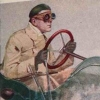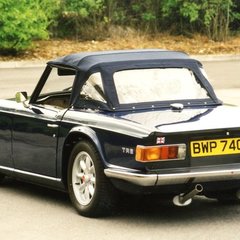-
Content Count
9,341 -
Joined
-
Last visited
About RobH

Profile Information
-
Location
Newbury, Berkshire
-
Cars Owned:
TR3A
MG M type
ex-TR7
ex- AH Sprite
ex- Saab 900turbo
ex- an assortment of 'grey porridge'
Recent Profile Visitors
4,739 profile views
-

Looking for a very early TR4 temperature gauge
RobH replied to Lebro's topic in For Sale, Swap or Wanted, maximum value £250
Nice work Bob. Those numbers for a GTR 104 are a similar but a bit different from others like this. Pity these are in degrees C so not directly comparable but they do seem to be considerably higher at the low temperature end (eg your 90F = 32C is 360 Ohms as opposed to 500 odd here) though the difference gets less further up the temperature range. I wonder what the variation is like between different examples of the senders ? -
True - a bit of a loose use of 'standard' on my part. I meant to convey that you didn't have to add a new switch.
-
It's just one possibility Phil - it might also be the battery but if it is only happening occasionally that is less likely. Intermittent things are the worst to try to fix. I don't think it is easy to dismantle a solenoid to look at the contacts - the case is swaged isn't it ?
-
It's possible the solenoid isn't pulling in fully I suppose but It's more likely that it has dodgy contacts. They might have burned a bit when Phil was operating it manually.
-
You can do that as standard on TR2-3 because the ignition switch and the starter button are separate. If the engine turns over slowly there may be a bad connection to the starter, the battery may be on the way out, the solenoid contact are bad or the starter itself is failing. Start by checking all the high current connections from the battery to the solenoid and starter, including earth return from the engine.
-
If someone really wants your car Phil, it will be on a trailer or in the back of a van and away. You say you already have a battery cutoff switch so another switch won't make any difference IMHO even if it is hidden -TRs with mechanical fuel pumps are dead easy to hot-wire once you are under the bonnet. One wire swap , a bump start and that's it. You could buy a Disklok - it won't stop professionals but it will certainly deter joyriders.
-
Any differences between CP and CR advance curves are probably a bit academic. They were both formulated for fuels which no longer exist - modern petrol is rather different and probably needs a rather different curve to get the best from it.
-
Edited because Peter replied while I was writing. Ideally you can do what he describes but you may find that In reality either the wires are stuck inside the tube and cannot be pulled out or that the push-fit joint between the control head and the stator tube has been permanently fixed by a previous owner (since it is a bit weak and easily damaged) so it might actually be necessary to withdraw the whole stator tube which means removing the olive at the bottom and losing all the steering box oil. There used to be a pdf in the technicalities section which seems to have disappeared
-

Replacing a potentiometer that controls a DC motor.
RobH replied to BlueTR3A-5EKT's topic in General TR Technical
The original is a 5k pot. the numbers '502' on the bottom tell you that - it means 50 + two noughts =5000 Yes the fact it is still connected means the reading is affected by the rest of the circuit. The resistance reading of the new pot should not leap about - if it does that means the wiper isn't contacting the wire track properly. It may be there is some oxidation on the wire track - you could try turning it from end-to-end rapidly a few times as that might clean it up (even though a new component shouldn't need it). Personally I would be inclined to use the ten-turn one -
You can really only try it to see whether it works or not - to test it properly needs specialist equipment. A few simple checks are possible which will at least tell you that there is continuity in the windings but they won't tell you whether there are any shorted turns ( where adjacent turns of the coil are shorted together and which will drastically affect operation) . You can measure the primary resistance ( between + and -) with an ohmmeter. If it is un-ballasted it should read around 3 Ohms while a ballasted one will be around 1.5 Ohms. The resistance between the HT conn
-
Thanks Stuart - slight memory malfunction there.
-
Or Vauxhall Cresta? The SA had front and rear wrap-around screens.
-
The TR7 wiring diagram shows just one connection from where the wiring branches to OSR and OSF lamps. The problem must be downstream of that otherwise the OSF lamp wouldn't work. Of course there is no guarantee that will be the same on your car and there's no info on where that connection is. [extract from diagram Copyright (C) 2017 Howard Brissenden]
-
Unfortunately it could be anywhere along the length Mike. There is no simple, practical way of locating it. I don't think there are any connectors in the run through cabin itself - there are bound to be some at the fascia and in the engine compartment though. \



